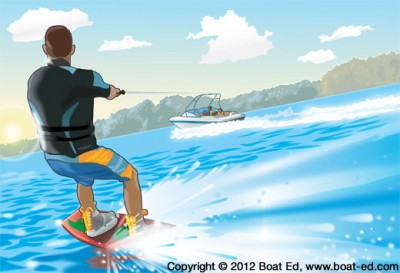
For many boaters, a beautiful summer day at the lake isn’t complete unless they have a chance to glide across the water on skis or wakeboards.
Water-skiing is fun and challenging for the person being towed as well as the person driving the boat. However, the skier and the driver require additional knowledge and skills to ensure their safety and the safety of others.
Even if you’ve taken a boater safety course, the following recommendations will help you stay safe, whether you’re the driver or the skier.
Before towing a skier, the boat driver should:
- Have a second person on board to act as an observer.
- Review hand signals with the skier so you’re both on the same page when communicating.
- Make sure the skier is wearing a U.S. Coast Guard-approved life jacket designed for water-skiing. A life jacket with a high-impact rating is recommended. Keep in mind that ski belts are not U.S. Coast Guard-approved.
- Be familiar with the area and aware of any hazards such as shallow water, rocks, or bridge pilings in the water.
- Make sure the tow lines are of the same length if towing multiple skiers.
- Never tow a skier at night. It is hazardous and illegal.
When starting to tow a skier, the boat driver should:
- Start the engine after making sure that no one in the water is near the propeller.
- Start the boat slowly until the ski rope is tight. When the skier is ready and there is no traffic ahead, take off in a straight line with enough power to pull the skier out of the water. Once the skier is up, adjust the speed according to the signals given by the skier.
- Some personal watercraft (PWC) models are capable of pulling water-skiers. However, it is recommended that the PWC be rated for at least three people—the driver, the observer, and the skier, even if it’s not required in your state.
While towing a skier, the boat driver should:
- Keep the skier at a safe distance—at least twice the length of the tow rope—from the shoreline, docks, hazards, and people in the water.
- Avoid congested areas, beaches, docks, and swimming areas. Water-skiing takes a lot of room. Some areas may have designated traffic patterns.
- Maintain a sharp lookout for other vessels and obstructions in the water. Let the observer watch the skier.
- Always respond to the skier’s signals. If you need to turn the boat, signal the skier of your intentions.
- Once the skier has dropped or fallen, circle the skier slowly either to return the tow line to the skier or to pick up the skier. Always keep the skier in view and on the operator’s side of the boat. Some states require the display of a red or orange skier-down flag under certain conditions.
- To avoid propeller injuries, always shut off the engine before allowing the skier to board the boat. After the skier is on board, retrieve the tow line unless you are pulling another skier.
When in the water, the skier should:
- Wear a life jacket. You never know when a fall will knock you unconscious.
- Learn to use hand signals.
- Never ski under the influence of drugs or alcohol. It is illegal and dangerous because of the damage to your judgment and reflexes.
- Never spray swimmers, vessels or other skiers. It is illegal, dangerous and discourteous.
- Never wrap any part of the tow rope around your body.
- Always hold a ski up out of the water after falling or after dropping the rope so that the boat driver and other boaters can see you.
- Never approach the back of the boat unless the engine has been shut off. Otherwise, you could be seriously injured by the boat’s propeller.
Check out the water-skiing video embedded below for more information.
httpv://youtu.be/dUJm7JJcZ70
You can learn more about boater safety by taking an online boat education course at boat-ed.com. The training offered at this site is approved by the state agencies responsible for boating safety education, and it’s the same material that’s taught in the classroom.
Studying at boat-ed.com is free. Those who must be certified before they can buy a boating license pay a one-time fee, which is due only if they pass the course. Online boater safety courses are available in participating states, so visit www.boat-ed.com to take a course specific to your state.
Photo and video: Boat-ed.com
 Your Privacy Choices
Your Privacy Choices
 The
The